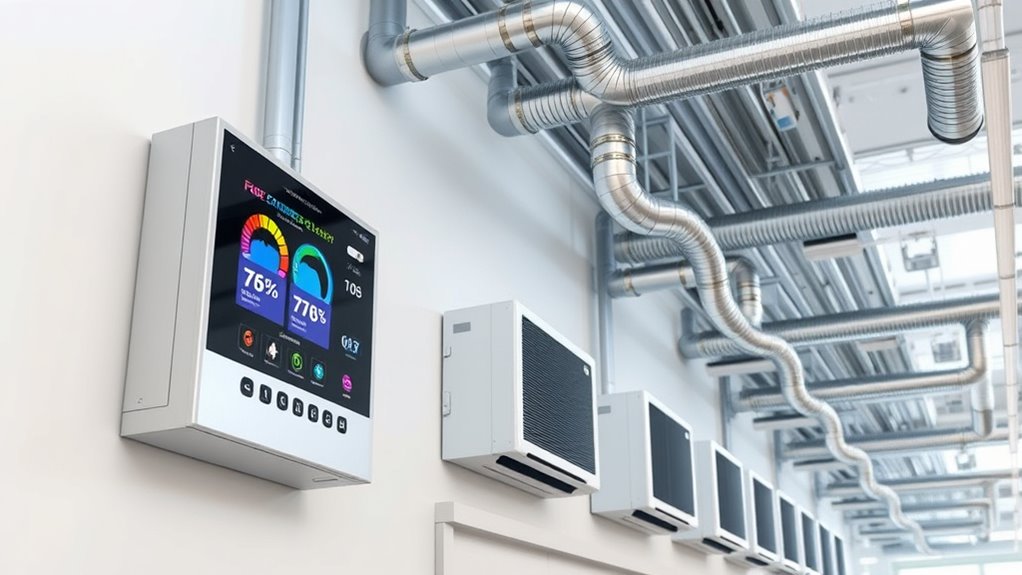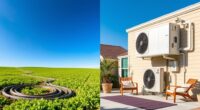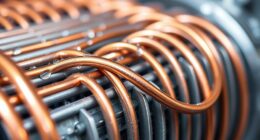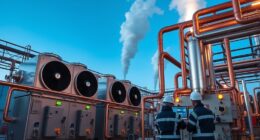VRF systems improve energy efficiency by precisely controlling refrigerant flow and adjusting compressor capacity to match your building’s needs. They modulate operation based on occupancy, demand, and zoning to minimize waste and reduce energy costs. Advanced inverter and AI-powered controls further boost performance and sustainability. By choosing VRF, you can enjoy significant savings and a greener footprint. Stay with us to discover how these smart systems transform climate control and maximize efficiency.
Key Takeaways
- VRF systems precisely modulate refrigerant flow and compressor capacity to match zone-specific heating and cooling demands, reducing energy waste.
- Advanced inverter technology and AI-powered controls optimize refrigerant and compressor operation for higher energy efficiency.
- Zoning capabilities allow independent temperature control in multiple areas, minimizing unnecessary energy consumption.
- Modular design and smart monitoring enable easier maintenance, system expansion, and long-term energy savings.
- Integration with smart grids and demand response features further enhance overall system efficiency and sustainability.
How VRF Systems Operate and Modulate Refrigerant Flow
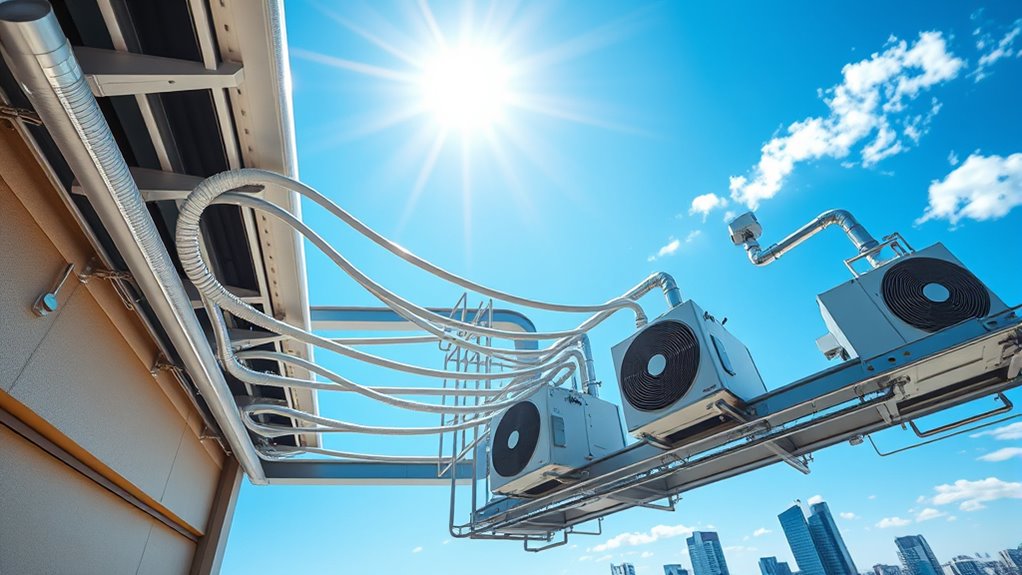
Variable Refrigerant Flow (VRF) systems operate by precisely controlling the amount of refrigerant sent to different indoor units, allowing for flexible and efficient heating or cooling. This is achieved through refrigerant modulation, which adjusts the flow based on the specific temperature needs of each zone. The system finely tunes compressor operation, varying its capacity to match demand instead of cycling on and off repeatedly. When less cooling or heating is needed, the compressor reduces its output, conserving energy and reducing wear. Conversely, during higher demand, it ramps up smoothly. This precise control ensures ideal comfort and efficiency, minimizing energy waste. By continuously modulating refrigerant flow and compressor operation, VRF systems deliver tailored climate control with exceptional responsiveness and reliability. Understanding system dynamics further enhances the ability to optimize performance and energy savings, especially as advancements in digital literacy programs support broader adoption and effective management of such technology.
Comparing VRF Technology to Traditional HVAC Systems

When comparing VRF technology to traditional HVAC systems, you’ll notice significant differences in energy efficiency, with VRF often using less power for the same comfort. Zoning capabilities also set VRF apart, allowing precise temperature control in different areas. Additionally, installation and maintenance tend to be more flexible and cost-effective with VRF systems, especially for complex or expanding setups. Furthermore, because of the regional variations in HVAC needs, VRF systems can be tailored to local climate conditions, enhancing their overall performance and reliability. Modern VRF systems also utilize advanced refrigerant management to optimize efficiency and reduce environmental impact. Incorporating comfort solutions for diverse spaces can further improve the adaptability and user satisfaction of VRF systems in various settings. Moreover, understanding the efficiency of heat pumps and their role in energy savings can help in designing more effective climate control solutions.
Energy Efficiency Differences
Are VRF systems truly more energy-efficient than traditional HVAC setups? Generally, yes. VRF technology adjusts refrigerant flow to match the specific heating or cooling needs of each zone, reducing energy waste. This targeted approach results in significant energy savings over time. When considering the cost comparison, initial investments may be higher, but the long-term operational savings often outweigh these costs. As more buildings adopt VRF systems, market adoption continues to grow, driven by their efficiency benefits and flexibility. Unlike traditional systems that run at full capacity regardless of demand, VRF units operate only when needed, optimizing energy use. Additionally, VRF systems utilize advanced controls that further enhance their efficiency and adaptability. Incorporating sound design techniques can also improve the overall performance and user comfort of VRF systems. Moreover, ongoing innovations in HVAC technology continue to push the boundaries of energy efficiency. Overall, VRF technology offers a smarter, more sustainable solution that can lead to notable efficiency gains.
Zoning Capabilities Comparison
VRF systems excel in zoning capabilities by allowing precise control over individual areas, unlike traditional HVAC setups that often rely on a single thermostat to regulate multiple zones. This zoning flexibility means you can customize temperature settings for each space, enhancing comfort and efficiency. Traditional systems face zoning limitations, often forcing you to compromise on individual preferences or install multiple units. With VRF technology, you can:
- Independently heat or cool different rooms simultaneously
- Adjust airflow to specific zones without affecting others
- Minimize energy waste by avoiding unnecessary heating or cooling
- Easily expand or modify zones without major system overhauls
This clarity in zoning control makes VRF systems a superior choice for tailored climate management, providing comfort where you need it most while reducing overall energy consumption. The versatility of VRF systems in managing different zones further enhances their appeal for modern building efficiency, especially when considering zoning regulations to optimize performance. Additionally, the ability to adapt to changing building layouts helps maintain system flexibility, which can contribute to improved energy efficiency over time. Incorporating smart control options can also optimize zone management and further reduce energy costs.
Installation and Maintenance
Installing VRF systems often involves a more streamlined process compared to traditional HVAC setups, thanks to their modular design and flexible configuration options. You’ll find that fewer ductwork modifications are needed, simplifying both installation and future adjustments. Maintenance is also more straightforward since many components are accessible and integrated with smart thermostats that allow remote monitoring. These thermostats help optimize indoor air quality by adjusting temperature and humidity levels automatically. Unlike traditional systems, VRF units generate less wear and tear, reducing downtime and repair costs. Regular checks on refrigerant levels and system calibration ensure peak efficiency. Additionally, preventive maintenance plays a crucial role in extending system lifespan and maintaining optimal performance. Incorporating easy-to-access components further enhances maintenance efficiency, allowing for quicker repairs and inspections. Overall, VRF systems offer easier maintenance and smarter operation, making them a practical choice for modern spaces focused on comfort and indoor air quality.
Energy Efficiency Benefits of VRF Solutions
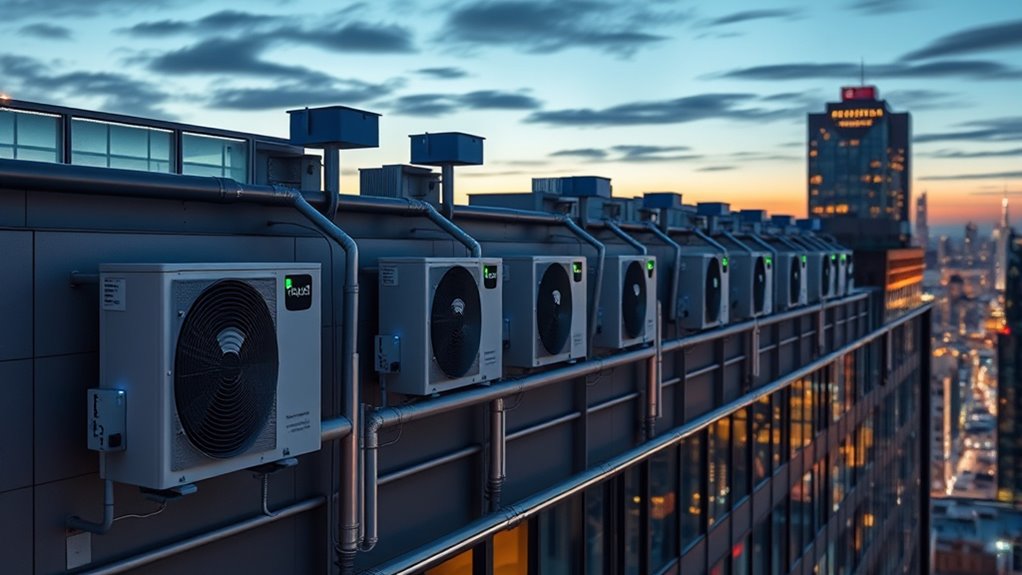
VRF systems can substantially cut your energy use by adjusting refrigerant flow to match your needs. With precise temperature control, you stay comfortable without wasting power. Plus, lower operating costs make VRF solutions a smart choice for your building’s efficiency.
Reduced Energy Consumption
Because of their advanced design, Variable Refrigerant Flow systems deliver significant energy savings compared to traditional HVAC solutions. They achieve this through zoning flexibility and efficient refrigerant management, targeting only occupied areas. Imagine:
- Adjusting cooling or heating precisely where needed, avoiding energy waste.
- Running multiple indoor units at different temperatures simultaneously.
- Using sensors to detect room occupancy, turning zones on or off automatically.
- Modulating refrigerant flow to match exact demand, reducing compressor workload.
These features ensure you use energy only for what’s necessary, cutting costs and lowering environmental impact. VRF systems adapt seamlessly to your building’s needs, optimizing performance without unnecessary energy consumption, and delivering consistent comfort while conserving energy.
Precise Temperature Control
When it comes to maintaining ideal comfort, precise temperature control is essential, and VRF systems excel at delivering it. Their ability to adjust refrigerant flow accurately guarantees each zone maintains the perfect temperature, reducing waste. Smart thermostats enhance this precision by allowing you to set customized schedules and respond automatically to changes, optimizing comfort and efficiency. With VRF technology, you gain finer control over indoor environments, preventing temperature fluctuations that waste energy. Additionally, consistent temperature management supports better indoor air quality, as stable conditions reduce humidity and mold growth. This level of control not only improves comfort but also ensures your space operates at peak efficiency, minimizing unnecessary energy use and enhancing overall sustainability. VRF systems truly set a new standard for precise, efficient climate management.
Lower Operating Costs
Implementing VRF systems can substantially lower your energy expenses by optimizing how and when your HVAC units operate. With smart thermostats, the system adjusts in real-time, reducing unnecessary energy use. Imagine:
- HVAC units running only when needed, not constantly.
- Zones heating or cooling independently for efficiency.
- Smart thermostats learning your schedule to conserve energy.
- Improved indoor air quality through precise control, reducing waste.
These features ensure you pay less on energy bills while maintaining comfort. VRF systems adapt quickly to changing conditions, minimizing waste. Better indoor air quality also means less reliance on energy-intensive air purification. Overall, you enjoy significant savings and a healthier environment, making VRF a smart investment for efficiency and cost reduction.
Cost Savings and Return on Investment With VRF Systems
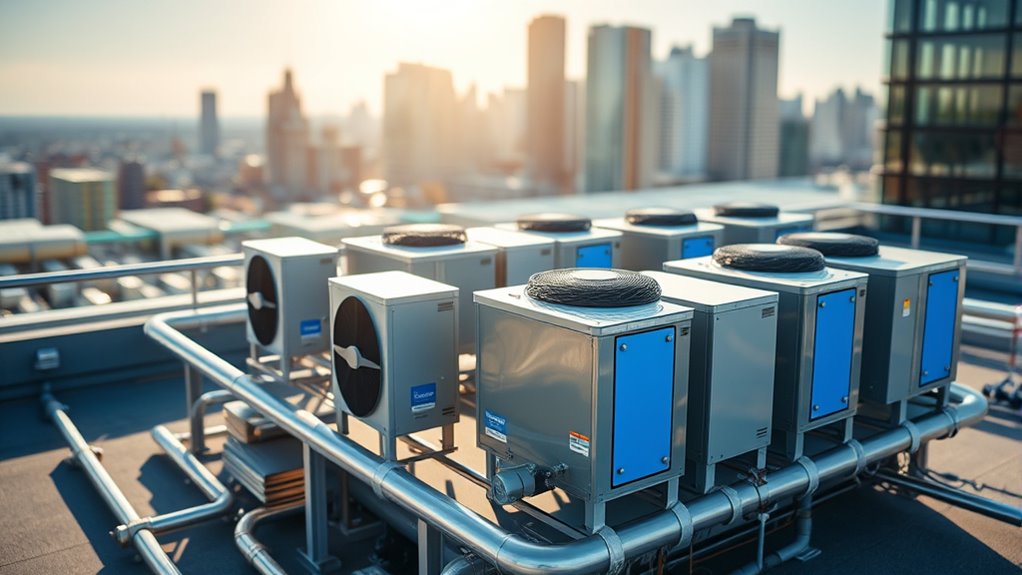
Variable Refrigerant Flow (VRF) systems are known for their ability to deliver significant cost savings over traditional HVAC solutions. When you do a thorough cost analysis, you’ll find that VRF systems reduce energy expenses and maintenance costs, leading to quicker investment return. Although initial setup might be higher, the savings generated through efficient operation and zoning capabilities offset this upfront expense. You’ll benefit from lower utility bills, less downtime, and reduced equipment replacement costs. Over time, these factors improve your overall financial picture, making VRF systems a smart investment. By carefully evaluating the long-term savings and operational efficiencies, you can confidently demonstrate a favorable return on investment, ensuring your HVAC system not only maintains comfort but also enhances your bottom line.
Flexibility in Design and Installation of VRF Systems
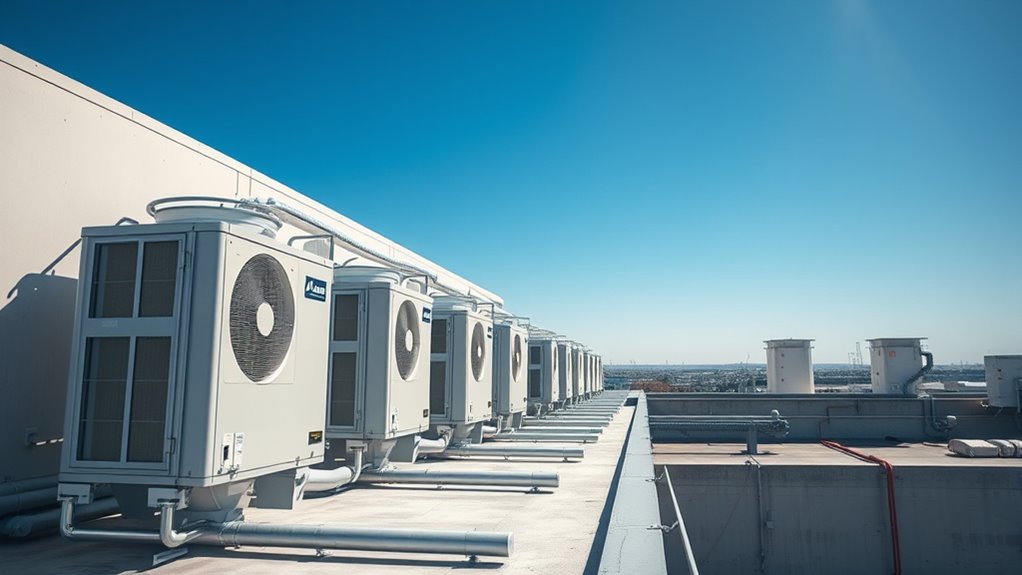
One of the key advantages of VRF systems is their remarkable flexibility in design and installation, allowing you to tailor the system to fit a wide range of building layouts and space constraints. Their modular design makes it easy to scale and adapt as your needs evolve. You can install indoor units in various configurations, from concealed ducted setups to wall-mounted units, enhancing aesthetic flexibility. Imagine:
VRF systems offer versatile, scalable, and aesthetic indoor unit options to suit any building layout.
- Connecting multiple indoor units across different floors seamlessly.
- Customizing the layout to maximize space efficiency.
- Integrating the system into existing structures without major disruptions.
- Achieving a sleek, unobtrusive appearance that complements your interior design.
This flexibility guarantees that VRF systems can meet both functional and aesthetic demands, making them ideal for diverse building types.
Environmental Impact and Sustainability Advantages

Because they operate using advanced inverter technology, VRF systems considerably reduce energy consumption compared to traditional HVAC solutions. This efficiency supports sustainable design by lowering your building’s overall environmental footprint. With less energy use, you contribute to significant greenhouse gas reduction, helping combat climate change. VRF systems also have a smaller refrigerant charge, which minimizes potential leaks and environmental risks. Their precise temperature control reduces waste and optimizes performance, making them an eco-friendly choice. By choosing VRF technology, you’re investing in a system that aligns with environmentally responsible goals. Overall, VRF systems enhance sustainability by combining energy savings, reduced emissions, and eco-conscious refrigerant management, making them a smart and environmentally friendly option for modern buildings.
Common Applications and Building Types for VRF Use
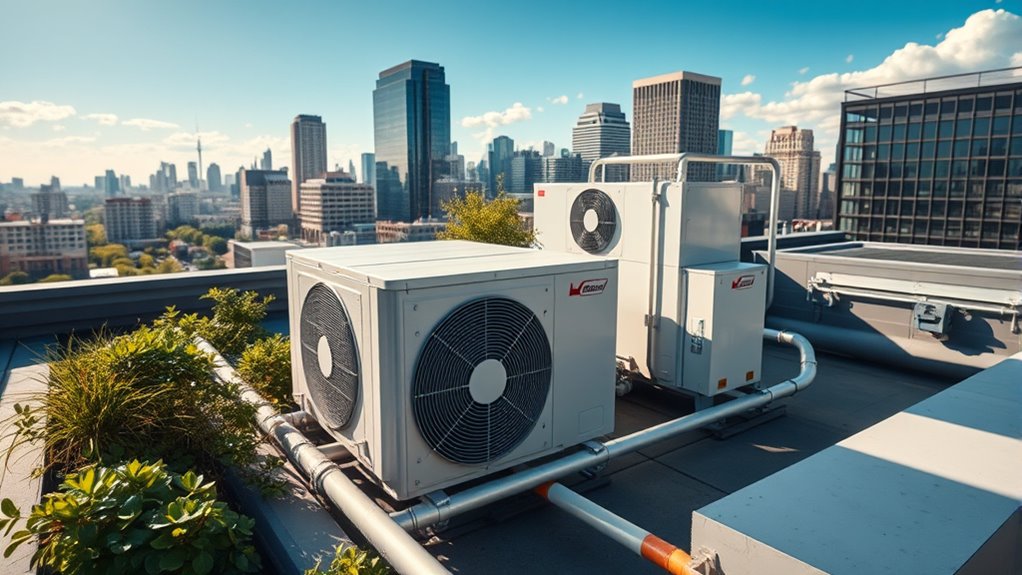
VRF systems are versatile and well-suited for a wide range of building types, making them a popular choice across various sectors. They excel in environments that require flexible zoning and efficient climate control. Imagine:
- Retail spaces with open layouts and multiple stores needing independent temperature zones.
- Educational facilities where classrooms demand tailored comfort levels.
- Hotels that benefit from centralized yet adaptable cooling and heating.
- Office buildings with varying occupancy patterns and diverse room sizes.
In retail environments, VRF systems help maintain ideal product conditions. In educational facilities, they improve comfort while reducing energy costs. Their adaptability makes them suitable for buildings with dynamic or complex layouts, ensuring comfort and efficiency across different applications.
Maintenance and Long-Term Performance of VRF Equipment

Maintaining the performance of VRF systems over time requires regular attention and proactive care. You should perform routine system diagnostics to identify potential issues early, guaranteeing ideal operation. Monitoring refrigerant levels helps detect leaks that can compromise efficiency and indoor comfort. If you notice a refrigerant leak, address it promptly to prevent system damage and energy losses. Regular inspections of filters, coils, and electrical connections also help sustain performance. Keeping the system clean and well-maintained extends its lifespan and reduces costly repairs. Additionally, working with qualified technicians for scheduled maintenance ensures that all components function correctly. Consistent care not only preserves the efficiency benefits of your VRF system but also saves you money in the long run by preventing unexpected breakdowns.
Future Trends and Innovations in VRF Technology
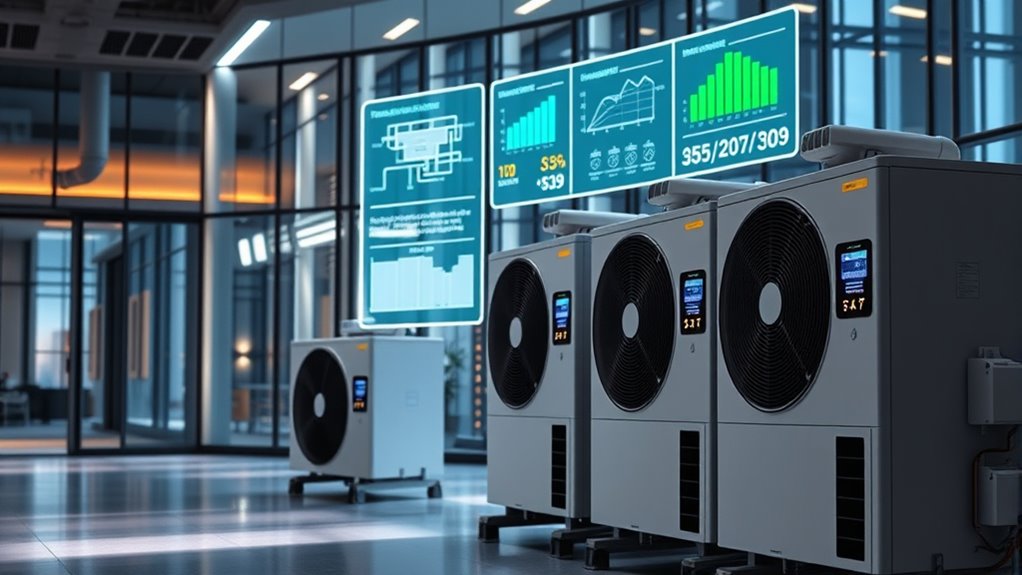
As technology advances, the future of VRF systems is poised for significant innovation, driven by the need for greater efficiency, sustainability, and smart integration. You’ll see smarter systems that adapt in real-time, optimizing energy use with predictive analytics. Imagine VRF units communicating seamlessly with a smart grid, balancing loads across the network. Innovations include:
Future VRF systems will be smarter, more efficient, and environmentally friendly through real-time adaptation and smart grid integration.
- AI-powered controls that forecast demand and adjust refrigerant flow proactively.
- Integration with smart grids to enhance energy efficiency during peak times.
- Enhanced sensors for precise monitoring of system performance.
- Modular designs allowing easy upgrades for future tech compatibility.
These advancements will make VRF systems more intelligent, adaptive, and environmentally friendly, helping you achieve higher savings while supporting sustainability goals.
Frequently Asked Questions
How Do VRF Systems Perform in Extreme Weather Conditions?
You might wonder how VRF systems handle extreme weather conditions. They perform well in weather resilience, adapting to temperature fluctuations to maintain comfort. During very hot or cold spells, they efficiently modulate refrigerant flow, ensuring consistent climate control. This adaptability helps preserve energy efficiency, even under harsh weather. So, with proper installation and maintenance, VRF systems can withstand extreme conditions while still delivering reliable, efficient performance.
What Are the Common Challenges in VRF System Installation?
Imagine you’re installing a VRF system in a busy office building. You might face challenges like installation complexity, especially when routing refrigerant piping through tight spaces or existing structures. Precise planning is vital, as improper piping can cause inefficiencies. You’ll need to coordinate with other trades and guarantee correct system setup. Overcoming these hurdles ensures peak performance, highlighting the significance of careful design and skilled installation for success.
How Does VRF Technology Impact Indoor Air Quality?
You might notice that VRF technology positively impacts indoor air quality by improving air filtration and humidity control. With precise temperature management, it reduces mold and bacteria growth, creating healthier environments. Additionally, advanced air filtration systems remove pollutants and allergens more effectively. As a result, you experience cleaner, more comfortable indoor air, enhancing overall well-being and comfort in your space.
Are VRF Systems Suitable for Small Residential Spaces?
Think of VRF systems as the Swiss Army knives of HVAC—compact yet versatile. They’re well-suited for small residential spaces because of their compact design and zoning flexibility, allowing you to control temperatures room-by-room. This means you can save energy and enjoy personalized comfort without bulky equipment cluttering your space. If you want efficient heating and cooling tailored to your home’s layout, VRF systems are a smart, space-saving choice.
What Training Is Required for Proper VRF System Maintenance?
You need proper training to maintain VRF systems effectively. Focus on learning maintenance protocols that cover system inspection, refrigerant handling, and troubleshooting. Additionally, obtaining technician certification guarantees you meet industry standards, enhances safety, and improves your expertise. Regular training updates are essential to stay current with the latest VRF technology and practices, helping you perform maintenance efficiently and avoid costly errors.
Conclusion
With VRF systems, you can achieve up to 40% energy savings compared to traditional HVAC setups. Their ability to precisely modulate refrigerant flow means you get efficient, flexible comfort tailored to your building’s needs. As more buildings adopt VRF technology, you’ll benefit from lower operational costs and a smaller environmental footprint. Embracing this innovative solution positions you ahead in sustainable, cost-effective climate control for years to come.
